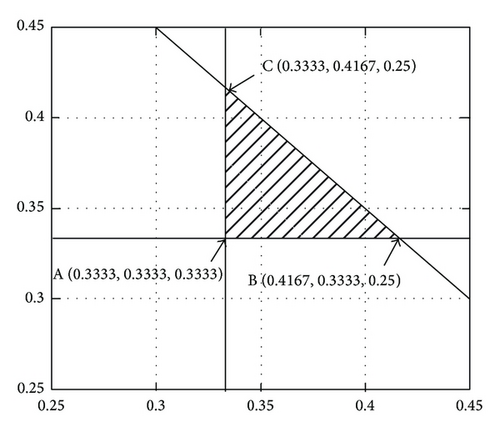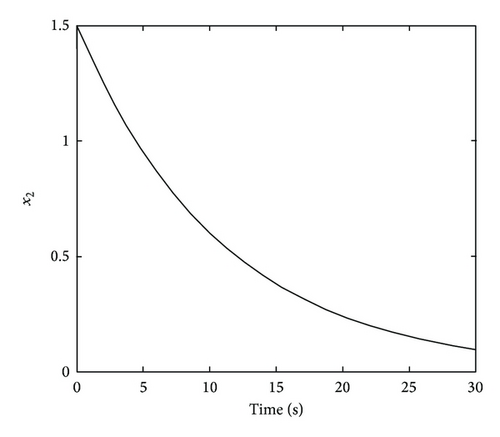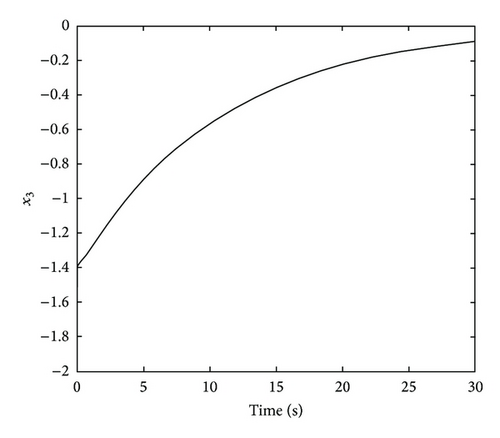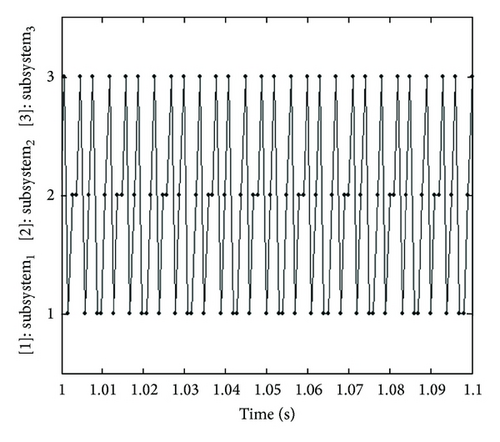On Delay Independent Stabilization Analysis for a Class of Switched Large-Scale Time-Delay Systems
Abstract
In view of the state-driven switching method, the sufficient stability conditions with delay independence will be derived for the switched large-scale time-delay systems. A new stability criterion of switched large-scale time-delay systems is deduced by Lyapunov stability theorem. The method can be applied to cases when all individual switched systems are unstable. Finally, one example is exploited to illustrate the proposed schemes.
1. Introduction
Switched systems form an important class of hybrid systems. Such systems can be described by a family of continuous-time subsystems (or discrete-time subsystems) and a rule that orchestrates the switching among them. It is well known that a wide class of physical systems in power systems, chemical procedure control systems, navigation systems, automobile speed change systems, and so forth may be appropriately described by the switched model [1–10]. In the study of switched systems, most works have been centered on the problem of stability. In the last two decades, there have been increasing interests in the stability analysis for such switched systems; see, for example, [11] and the references cited therein.
Two important methods are used to construct the switching law for the stability analysis of the switched systems. One is the state-driven switching strategy; the other is the time-driven switching strategy. The time-driven switching method is formed based on the main concept of a dwell time. If at least one stable subsystem exits, then the switched system is stable with a proper dwell time switching law. However, in reality, it is not unusual to encounter cases in which all subsystems are unstable. Therefore, [6] proposed that all subsystem can be unstable for time-driven switching method. We would have to turn to the state-driven switching strategy, from which many choices of switching laws ensuring stability exist, even if all the subsystems are unstable. Reference [5] proposed quadratic stabilizability via state feedback for both continuous-time and discrete-time switched linear systems that are composed of polytopic uncertain subsystems. For continuous-time switched linear systems, if there exists a common positive definite matrix for stability of all convex combinations of the extreme points which belong to different subsystem matrices, then the switched system is quadratically stabilizable via state feedback. The switching rules can be obtained by using the obtained common positive definite matrix.
Furthermore, the time-delay phenomenon is also unavoidable in practical systems, for instance, chemical process, long distance transmission line, hybrid procedure, electron network, and so forth. Time delays may cause instability and poor performance for practical systems [12]. In view of the aforementioned facts, the stability of switched systems with time delay is very worthy of research [13, 14]. Reference [13] studied stability and L2 gain properties for a class of switched systems which are composed of a finite number of linear time-invariant symmetric systems with time delay and showed that, when all subsystems are in sense of satisfying an LMI, the switched system is asymptotically stable under arbitrary switching. Reference [14] proposed a delay-dependent robust H∞ controller design method for the uncertain linear switched systems with time delay. Reference [15] investigated the problem of robust L∞ reliable control for uncertain switched nonlinear systems with time delay and actuator failures. References [16, 17] concerned with the problem of delay-dependent stability analysis for a class of two-dimensional discrete switched systems described by the Roesser model with state delays. Besides, a large-scale system is often considered as a set of interconnected subsystems. The advantage of this aspect in stability analysis is to reduce complexity [18, 19]. Recently, many approaches have been used to investigate the stability and stabilization of large-scale time-delay systems [20, 21]. Therefore, the stability analysis of switched large-scale time-delay systems is very worthy to be researched.
Basically, current efforts to achieve stability in time-delay systems can be divided into two categories, namely, delay-independent criteria and delay-dependent criteria. For the delay-dependent criteria, the Lyapunov-Krasovskii functional technique is most suitable for application; the proposed criterion adopting this technique performs much better than several existing criteria [22–24]. In this paper, the delay-independent stability of switched large-scale time-delay system is considered. In view of the state-driven switching method, a new stability criterion of switched large-scale time-delay system is deduced by Lyapunov stability theorem [25]. This method can be applied to cases when all individual switched systems are unstable.
The following notations will be used throughout the paper: λ(A) stands for the eigenvalues of matrix A, λmax (A) means the maximum eigenvalue in matrix A; that is, λmax (A) = Max [λ(A)], ∥A∥ denotes the norm of matrix A; that is, ∥A∥ = Max [λ(ATA)] 1/2, and AT is the transpose of matrix A.
2. System Description and Problem Statement
where are the state vectors of the ith subsystem, i = 1, 2, …, N,, and Bσ(x)_ij are some constant matrices of compatible dimensions, , and σ(x(t)) : Rn → {1, 2, …, r} is a piecewise constant function of time, called a switch signal; that is, the matrix Aσ(x)_ii switches between matrices A1_ii, A2_ii, …, Ar_ii belonging to the set A ≡ {A1_11, A2_ii, …, Ar_ii} and Al_ii l ∈ {1, 2, …, r}. The matrix Bσ(x)_ij switches between matrices B1_ij, B2_ij, …, Br_ij belonging to the set B ≡ {B1_ij, B2_ij, …, Br_ij} and Bl_ij, i, j ∈ {1, 2, …, N}. Aσ(x)_ii, Aσ(x)_ij, and Bσ(x)_ij are matrices of compatible dimensions. τ > 0 is the time-delay duration. ψi(t) is a vector-valued initial continuous function defined on the interval [−τ, 0], and finally ψi(t), defined on −τ ≤ t ≤ 0, is the initial condition of the state, N is the number of interconnected subsystems, n is the whole systems dimension, and r is the number of individual systems.
As we have indicated, very few research articles have ever discussed the stability of the switched time-delay large-scale system (1a) and (1b). To facilitate our analysis later, some helpful lemmas are given below first.
Lemma 1 (see [26].)The stability with delay independence of system (2) implies the stability with delay independence for the following systems:
Lemma 2. There exists a switching law for the switched system (1a) and (1b) such that the system is asymptotically stable if there exist positive constants αi (1 ≤ i ≤ N) satisfying such that the convex combination of the whole switched time-delay system
Proof. Since there exist positive numbers αi (1 ≤ i ≤ N) such that is asymptotically stable, there exists a Lyapunov function V(x) such that
Remark 3. Condition (6) will be used to design switching laws. The technique is that the switching is forced so that the active system is always in the region corresponding to the Lyapunov function with negative derivative.
Lemma 4. In view of Lemma 1, the stability with delay independence of implies the stability with delay independence for the following systems:
Thus, the system (7) is an asymptotically stable system; then, the system (4) is stable. That is, the switched time-delay system (1a) and (1b) is also stable.
A sufficient condition for stability of the switched time-delay large-scale system (1a) and (1b) is established in the following theorem by using the state-switched method.
3. Stabilization Analysis of Switched Large-Scale Time-Delay System
In the light of Lemma 2, it is obvious that the stability of the switched time-delay system ((10a), (10b), and (10c)) is equivalent to that of the system
Theorem 5. Suppose the switched large-scale time-delay system (1a) and (1b) with r = N = 2. There exists a switching law such that the switched large-scale time-delay system (1a) and (1b) is asymptotically stable of delay independence, if constant and there matrices P1, P2 > 0 satisfying
Proof. The Lyapunov function for the overall system is
Furthermore, let α1 = α, α2 = 1 − α; therefore,
If inequalities ((16a), (16b) and, (16c)) are satisfied and constant , then . Hence, there exists a switching law such that system (1a) and (1b) is asymptotically stable.
Now, another sufficient condition for the stabilization of switched large-scale time-delay system (1a) and (1b) with r = N switched subsystems is addressed as the following theorem.
Theorem 6. Suppose the switched large-scale time-delay system (1a) and (1b) with N switched subsystems, and then there exists a switching law such that switched large-scale time-delay system (1a) and (1b) is asymptotically stable of delay independence if constants αl satisfy
Corollary 7. The nominal large-scale switched systems (1a) and (1b) without time-delay, that is, Bl_ij = 0, and then there exists a switching law such that switched large-scale system is asymptotically stable if constants αl satisfy
Furthermore, we can develop another method to investigate the stability of switched large-scale time-delay systems (1a) and (1b).
Now, another sufficient condition for the stabilization of switched large-scale time-delay system (1a) and (1b) with r = N = 2 is addressed as the following theorem.
Theorem 8. Suppose the switched time-delay system (1a) and (1b) with r = N = 2. These exists a switching law such that the switched time-delay system (1a) and (1b) is asymptotically stable of delay independence if constant and there matrices P1, P2 > 0 satisfying
Proof. The Lyapunov function for the overall system is
The differential of the Lyapunov function (37) is as follows
If inequalities ((36a), (36b), and (36c)) are satisfying and constant , then . Hence, there exists a switching law such that system (1a) and (1b) is asymptotically stable.
Now, a sufficient condition for the stabilization of switched large-scale time-delay system (1a) and (1b) with r = N switched systems is addressed as the following theorem.
Theorem 9. Suppose the switched large-scale time-delay system (1a) and (1b) with arbitrary N switched systems, and then there exists a switching law such that switched large-scale time-delay system (1a) and (1b) is asymptotically stable of delay independence if constants αl satisfy
Corollary 10. The nominal switched large-scale systems (1a) and (1b) without time-delay, that is, Bl_ij = 0, and then there exists a switching law such that switched large-scale system is asymptotically stable if constants αl satisfy
Remark 11. The main contribution of the results is that this method can be applied to cases when all individual switched systems are unstable in this paper.
4. Numerical Example
Example 12. Consider a switched time-delay system composed of three individual switched systems given as follow.
Switched System 1:
Via normal tests of stability for the large-scale time-delay system, three individual switched systems ((42a), (42b), and (42c)) are all unstable. Furthermore, according to Lyapunov equation (26), the Pi (i = 1, 2, 3) can be obtained as the following:

Therefore, α1 and α2 are selected inside the admissible region of the triangle as shown in Figure 2.



The trajectories of the switched large-scale time-delay system ((42a), (42b), and (42c)) and the switching during period [0.5, 0.6] sec are shown in Figure 3 with initial value and τ = 0.5 sec.

5. Conclusion
We have shown that the Lyapunov stability theorem can deal with the stabilization of switched large-scale time-delay systems. In addition, it is shown that the main advantages of our approach are that it can be applied to cases when all individual switched systems are unstable, quantify the region of stability, extend to arbitrary subsystems of switched large-scale time-delay systems, and develop the simple switching rule to stabilize the switched large-scale time-delay systems. For future research, we are interested in topics such as the stability problems of designing the switched laws with time dependency for the switched large-scale time-delay systems?
Acknowledgment
This work is supported by the National Science Council, Taiwan, under Grand nos. NSC 102-2221-E-218 -017 and NSC100-2632-E-218-001-MY3.




